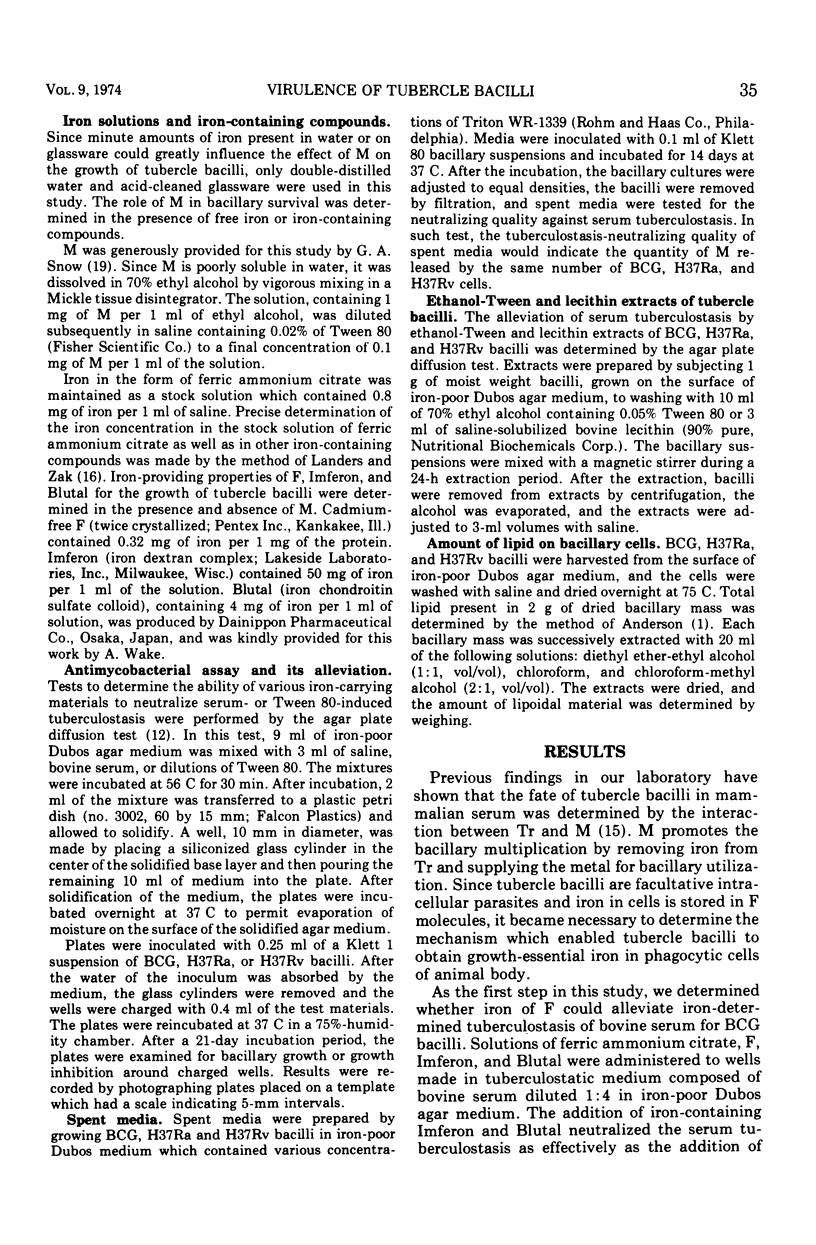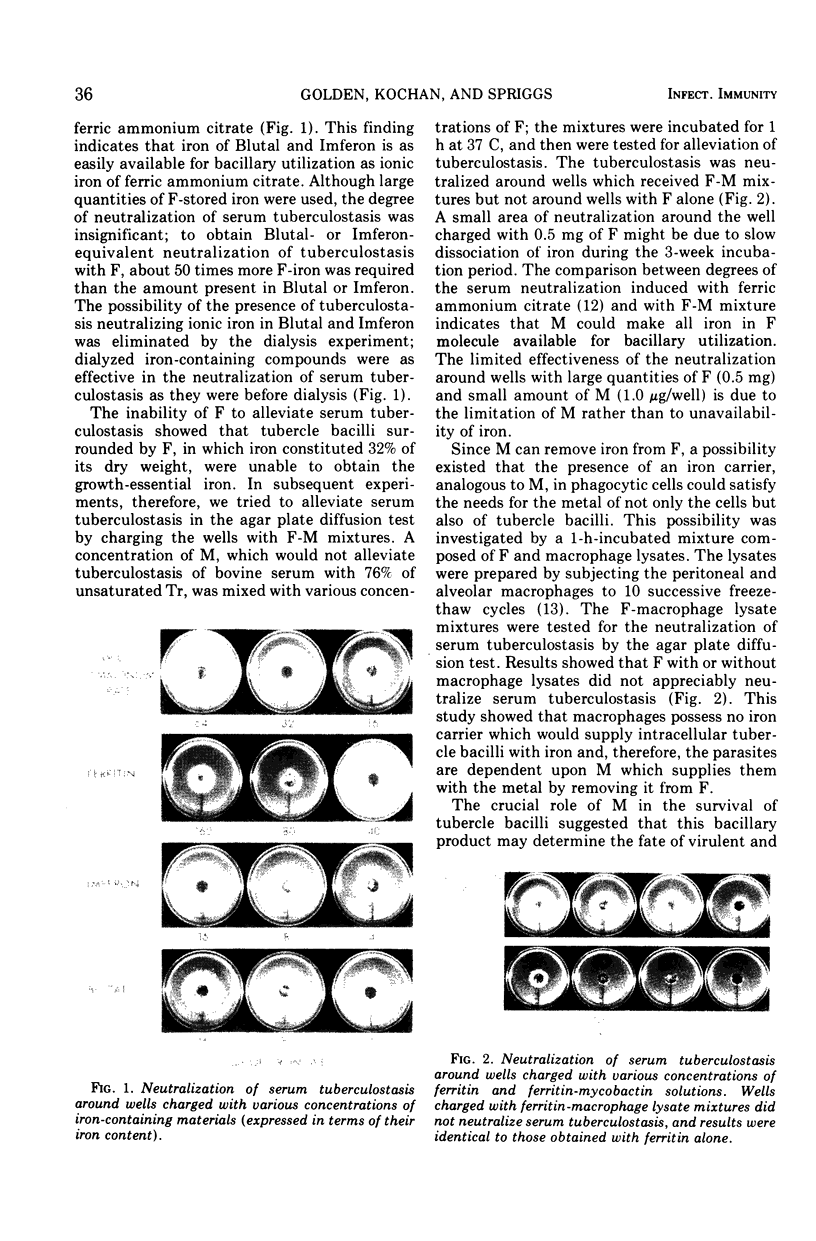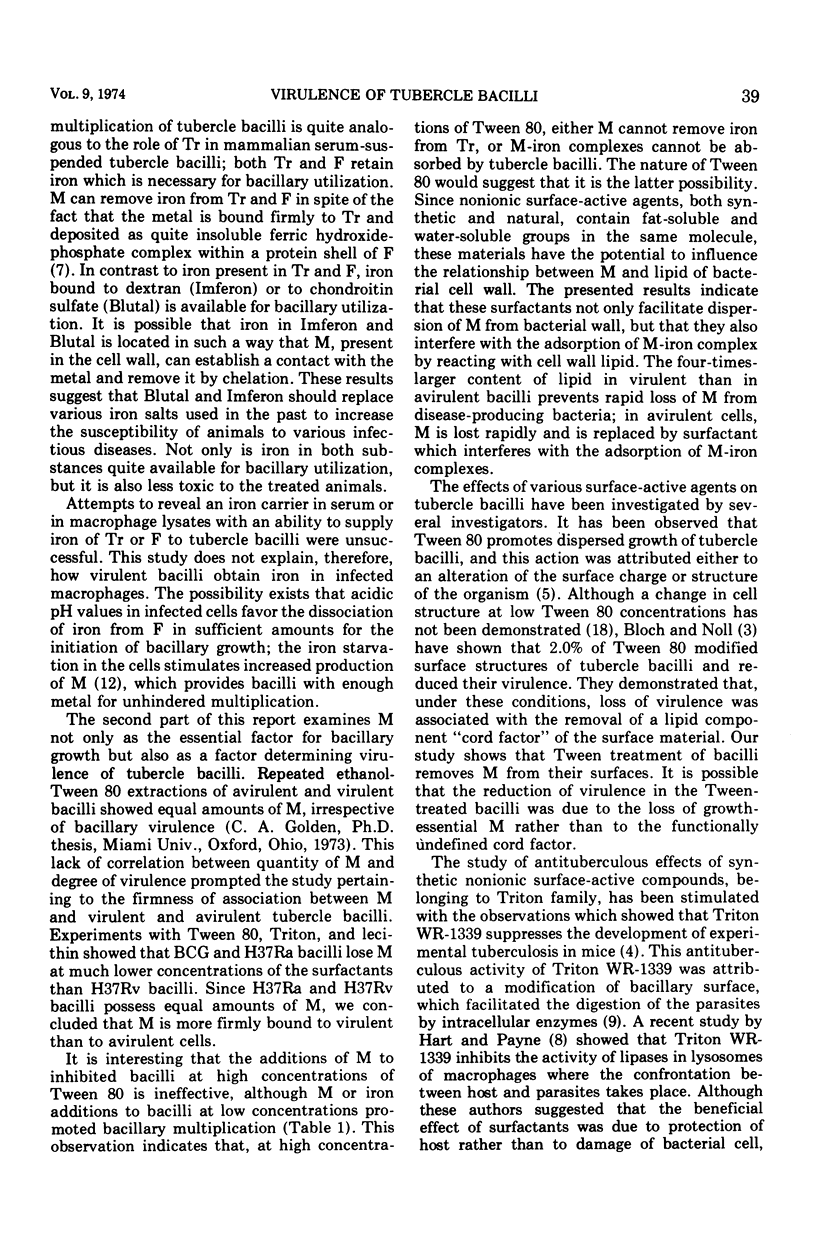Abstract
Tubercle bacilli failed to grow in iron-void media enriched with solutions of iron-containing transferrin (Tr) or ferritin (F) because these substances do not provide the bacilli with iron, which is essential for their growth. Animal serum and macrophages possessed no iron carrier with an ability to satisfy the need of the bacteria for the metal. Mycobactin (M), the growth-product of tubercle bacilli, removed iron from Tr and F and supplied the metal for bacillary utilization. The role of M in the growth of tubercle bacilli was influenced by nonionic surfactants which inhibited bacillary growth by removing M from the bacillary cells and interfering with the absorption of M-iron complexes. Experiments with Tween 80, Triton WR-1339, and lecithin showed that avirulent bacilli lose M at lower concentrations of the surfactants than virulent bacilli. Since avirulent and virulent bacilli possess the same amount of M, these findings indicate that M is bound more firmly to lipid-rich virulent than lipid-poor avirulent cells. These findings indicate that the resistance of virulent bacilli to the M-removing activity of the surfactants is an indicator of their ability to multiply in the infected host and may be used as a measure of bacillary virulence.
Full text
PDF






Images in this article
Selected References
These references are in PubMed. This may not be the complete list of references from this article.
- Armstrong B. A., Sword C. P. Electron microscopy of Listeria monocytogenes-infected mouse spleen. J Bacteriol. 1966 Mar;91(3):1346–1355. doi: 10.1128/jb.91.3.1346-1355.1966. [DOI] [PMC free article] [PubMed] [Google Scholar]
- BLOCH H., NOLL H. Studies on the virulence of tubercle bacilli; variations in virulence effected by tween 80 and thiosemicarbazone. J Exp Med. 1953 Jan;97(1):1–16. doi: 10.1084/jem.97.1.1. [DOI] [PMC free article] [PubMed] [Google Scholar]
- CORNFORTH J. W., HART P. D., REES R. J. W., STOCK J. A. Antituberculous effect of certain surface-active polyoxyethylene ethers in mice. Nature. 1951 Jul 28;168(4265):150–153. doi: 10.1038/168150a0. [DOI] [PubMed] [Google Scholar]
- Hart P. D., Payne S. N. Effects of non-ionic surfactants that modify experimental tuberculosis on lipase activity of macrophages. Br J Pharmacol. 1971 Sep;43(1):190–196. doi: 10.1111/j.1476-5381.1971.tb07168.x. [DOI] [PMC free article] [PubMed] [Google Scholar]
- Kochan I., Cahall D. L., Golden C. A. Employment of tuberculostasis in serum-agar medium for the study of production and activity of Mycobactin. Infect Immun. 1971 Aug;4(2):130–137. doi: 10.1128/iai.4.2.130-137.1971. [DOI] [PMC free article] [PubMed] [Google Scholar]
- Kochan I., Golden C. A. Antimycobacterial effect of lysates prepared from immunologically activated macrophages. Infect Immun. 1973 Sep;8(3):388–394. doi: 10.1128/iai.8.3.388-394.1973. [DOI] [PMC free article] [PubMed] [Google Scholar]
- Kochan I., Golden C. A., Bukovic J. A. Mechanism of tuberculostasis in mammalian serum. II. Induction of serum tuberculostasis in guinea pigs. J Bacteriol. 1969 Oct;100(1):64–70. doi: 10.1128/jb.100.1.64-70.1969. [DOI] [PMC free article] [PubMed] [Google Scholar]
- Kochan I. Mecahnism of tuberculostasis in mammalian serum. I. Role of transferrin in human serum tuberculostasis. J Infect Dis. 1969 Jan;119(1):11–18. doi: 10.1093/infdis/119.1.11. [DOI] [PubMed] [Google Scholar]
- Kochan I., Pellis N. R., Golden C. A. Mechanism of Tuberculostasis in Mammalian Serum III. Neutralization of Serum Tuberculostasis by Mycobactin. Infect Immun. 1971 Apr;3(4):553–558. doi: 10.1128/iai.3.4.553-558.1971. [DOI] [PMC free article] [PubMed] [Google Scholar]
- Kochan I. The role of iron in bacterial infections, with special consideration of host-tubercle bacillus interaction. Curr Top Microbiol Immunol. 1973;60:1–30. doi: 10.1007/978-3-642-65502-9_1. [DOI] [PubMed] [Google Scholar]
- LANDERS J. W., ZAK B. Determination of serum copper and iron in a single small sample. Am J Clin Pathol. 1958 Jun;29(6):590–592. doi: 10.1093/ajcp/29.6_ts.590. [DOI] [PubMed] [Google Scholar]
- Snow G. A. Mycobactins: iron-chelating growth factors from mycobacteria. Bacteriol Rev. 1970 Jun;34(2):99–125. doi: 10.1128/br.34.2.99-125.1970. [DOI] [PMC free article] [PubMed] [Google Scholar]
- Weinberg E. D. Role of iron in host-parasite interactions. J Infect Dis. 1971 Oct;124(4):401–410. doi: 10.1093/infdis/124.4.401. [DOI] [PubMed] [Google Scholar]




